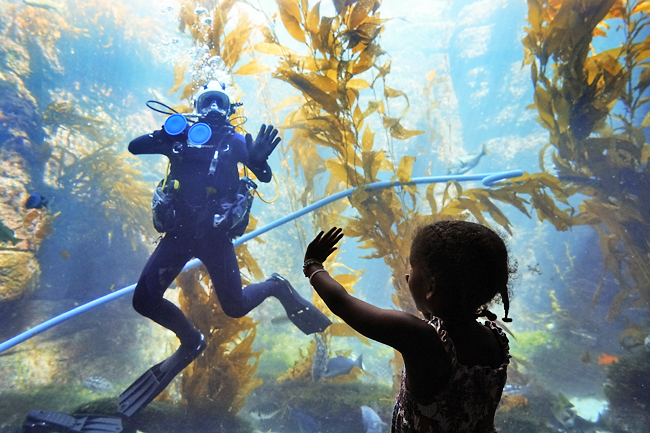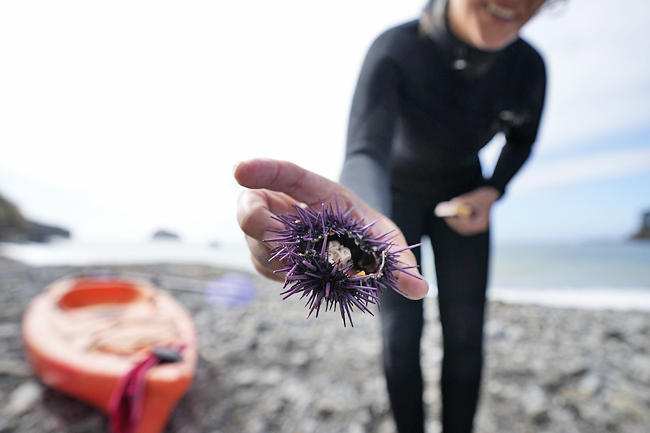CASPAR BEACH, CALIFORNIA (AP) – A welding hammer strapped to her wrist, Joy Hollenback slipped on blue fins and swam into the churning, chilly Pacific surf one fall morning to do her part to save Northern California’s vanishing kelp forests.
Hollenback floated on the swaying surface to regulate her breathing before free diving into the murky depths towards the seafloor. There, she spotted her target: voracious, kelp-devouring purple urchins.
Within seconds she smashed 20 to smithereens. “If you’re angry, it’s a cathartic way to get it all out,” Hollenback joked. “It’s ecologically sanctioned mayhem.”
The veterinarian who lives in Berkeley, California is part of a crew of volunteers who swim, snorkel and dive armed with pick axes and hammers on a sole mission: to crush purple urchins that largely destroyed 96 per cent of California’s iconic bull kelp forests between 2014 and 2020, and with it harmed red abalone and other sea life they supported.
The pilot project off the Mendocino County coast is one of many initiatives California is testing to save such leafy marine ecosystems, which are declining worldwide due to climate change.
Kelp forests play an integral role in the health of the world’s oceans, one of the issues discussed at the United Nations climate summit in Dubai.
Based on early observations, efforts like urchin culling appear to be helping.




Biologists said they started to see small successes with the experiments started several years ago, offering hope of reversing destruction likened to a rainforest being clear-cut.
Healthy patches of kelp and schools of fish returned this summer to small sections where urchins were crushed at Caspar Cove, 200 kilometres north of San Francisco.
Nearby at Albion Bay, where commercial divers removed many of the urchins in 2021, biologists put tiny kelp grown in a lab on 30-metre lines. In August, they discovered the kelp not only had reached the surface, but was reproducing.
“That’s the first time we know of that happening in an open coastal environment,” said Norah Eddy of The Nature Conservancy, one of several organisations participating in the experiment. “What we want is for the kelp to start putting out babies. This is showing these methods can be done in these kinds of rugged environments.”
There are still huge challenges to overcome before California’s bull kelp is on the path to recovery. But scientists said the progress has relieved fears the forests were lost forever.
“This is really setting the system up to hold on to the kelp that we do have until we’re in a better place,” said Kristen Elsmore, a senior scientist at the California Department of Fish and Wildlife.
Scientists will be collecting data over the next three years to determine what methods are most effective as California builds its first plan to restore and manage kelp.
Kelp was so abundant that the state managed it solely as a fishery, overseeing commercial and recreational harvests. Under the plan, kelp will be managed now as an ecosystem, reflecting the heightened understanding of kelp’s importance.
“Kelp forms whole forests that are supporting so many other species and so it just has this cascading effect on the near-shore ecosystem when you lose your kelp,” Elsmore said.
“You’re losing a whole forest, not just one species.”
The plan could inform restoration efforts from Australia to Chile, where kelp faces similar threats.
“The ultimate goal is for these systems to really be self-sustaining and the restoration part to really just be giving it a gentle nudge in the right direction,” the scientist said.
Kelp has been disappearing as a warming planet raises ocean temperatures.
Along the West Coast, the problem started after 2013 when a warm water mass nicknamed “the blob” developed off Alaska and stretched south, lingering for four years as it wreaked havoc on marine ecosystems all the way to Mexico’s Baja California peninsula.
At the same time, a mysterious wasting disease decimated sunflower sea stars, causing their arms to fall off and turning them into gooey masses, killing 90 per cent of the population.
The star fish is the main purple urchin predator. After the disease killed over five billion sea stars, the urchin population exploded, devouring kelp and leaving seascapes with almost nothing but the spiny, globular echinoderms.
The kelp loss prompted the California Fish and Game Commission to close its recreational red abalone fishery in 2018. Commercial harvests of red urchins have also been hurt. Red urchins are favoured over the purple urchins because they contain more edible uni or roe inside, but commercial divers say the amount has shrunk with less kelp.
Bull kelp, an annual seaweed, starts as a microscopic spore that grows up to 60 centimetres per day until it reaches up to 98 feet 30 metres before dying off in the cooler months. It flourishes in cool, nutrient-rich waters.
California’s coast has bull and giant kelp, the world’s largest marine algae. Urchins have hurt both species, though giant kelp forests have fared better.
Some believe the only way to restore kelp is to reduce the purple urchins, which can go dormant for years only to remerge and eat new kelp growth. Chefs have started serving purple urchins to build a market.
“Sometime it does feel weird, like you’re killing this animal that’s a native species, but it’s for the greater good,” said Morgan Murphy-Cannella of Reef Check Foundation, the kelp restoration coordinator involved in the kelp planting at Albion Bay. – Julie Watson






